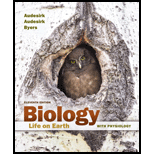
Concept explainers
Insects are the largest group of animals on Earth. Insect diversity is greatest in the tropics, where habitat destruction and species extinction are occurring at an alarming rate. What biological, economic, and ethical arguments can you advance to persuade people and governments to preserve this biological diversity?
To discuss:
The biological, economic, and ethical aspects regarding the preservation of insects.
Introduction:
The insects are included in the arthropods. The insects have an exoskeleton made up of chitin, three pairs of legs, and a segmented body. The insects are a major part of the ecosystem.
Explanation of Solution
All the living organisms are interdependent for their survival. The richness of plants and animals in a distinct habitat determines the biodiversity of that region. The services offered by nature reduced by the loss of biodiversity.
Biological importance:
One of the efficient methods of pollination is insect-pollination. The insects, such as bees and flies transfer the pollen grains to the other flowers of the same or different plants. This leads to the increase in pollination, thus benefiting the plants. The bees and flies attracted to the flowers for the nectar produced by the flowers. Some of the insects are decomposers and help in maintaining the richness of soil and aerate the soil by digging holes as their homes.
Economic importance:
Some of the insects are highly valuable in terms of products that are obtained from them. The silk, lacquer, wax, and honey is obtained and they are economical to humans.
Ethical importance:
Diseases developed by the microbes transmitted by insects every year affect the humans. The insects should be preserved even if insects are harming humans because every life form is important for the continuation of life on Earth. Any sort of disturbance in levels of life forms will affect all the life forms.
The insects are important in terms of economic, biological, and ethical aspects because the balance of all life forms is necessary for the well functioning of the life cycle of all organisms on this planet.
Want to see more full solutions like this?
Chapter 24 Solutions
Biology: Life on Earth with Physiology (11th Edition)
- Find out about the organisations and the movements aimed at the conservation of our natural resources. Eg Chipko movement and Greenpeace. Make a project report on such an organisation.arrow_forwardWhat are biofertilizers and mention the significancearrow_forwardPCBs and River Otters: Otters in Washington State’s Green-Duwamish River have high levels of polychlorinated biphenyls (PCBs) in their livers. PCBs can bind to the estrogen receptors in animals and disrupt the endocrine system of these otters. The PCBs seem to increase the estrogen to androgen ratio, skewing the ratio toward too much estrogen. How would increased estrogen affect the river otter population? Based on your reading of the materials in this unit, what factors can affect fertility in humans? Explain how each of the factors affecting human fertility that you described can disrupt the human endocrine system to affect reproduction.arrow_forward
- Other than oil and alcohol, are there other liquids you could compare to water (that are liquid at room temperature)? How is water unique compared to these other liquids? What follow-up experiment would you like to do, and how would you relate it to your life?arrow_forwardSelection of Traits What adaptations do scavengers have for locating and feeding on prey? What adaptations do predators have for capturing and consuming prey?arrow_forwardCompetition Between Species What natural processes limit populations from growing too large? What are some resources organisms can compete over in their natural habitat?arrow_forward
- Species Interactions Explain how predators, prey and scavengers interact. Explain whether predators and scavengers are necessary or beneficial for an ecosystem.arrow_forwardmagine that you are conducting research on fruit type and seed dispersal. You submitted a paper to a peer-reviewed journal that addresses the factors that impact fruit type and seed dispersal mechanisms in plants of Central America. The editor of the journal communicates that your paper may be published if you make ‘minor revisions’ to the document. Describe two characteristics that you would expect in seeds that are dispersed by the wind. Contrast this with what you would expect for seeds that are gathered, buried or eaten by animals, and explain why they are different. (Editor’s note: Providing this information in your discussion will help readers to consider the significance of the research).arrow_forwardWhat is the difference between Uniporters, Symporters and Antiporters? Which of these are examples of active transport?arrow_forward
 Concepts of BiologyBiologyISBN:9781938168116Author:Samantha Fowler, Rebecca Roush, James WisePublisher:OpenStax College
Concepts of BiologyBiologyISBN:9781938168116Author:Samantha Fowler, Rebecca Roush, James WisePublisher:OpenStax College Biology: The Dynamic Science (MindTap Course List)BiologyISBN:9781305389892Author:Peter J. Russell, Paul E. Hertz, Beverly McMillanPublisher:Cengage Learning
Biology: The Dynamic Science (MindTap Course List)BiologyISBN:9781305389892Author:Peter J. Russell, Paul E. Hertz, Beverly McMillanPublisher:Cengage Learning Biology 2eBiologyISBN:9781947172517Author:Matthew Douglas, Jung Choi, Mary Ann ClarkPublisher:OpenStax
Biology 2eBiologyISBN:9781947172517Author:Matthew Douglas, Jung Choi, Mary Ann ClarkPublisher:OpenStax
 Biology Today and Tomorrow without Physiology (Mi...BiologyISBN:9781305117396Author:Cecie Starr, Christine Evers, Lisa StarrPublisher:Cengage Learning
Biology Today and Tomorrow without Physiology (Mi...BiologyISBN:9781305117396Author:Cecie Starr, Christine Evers, Lisa StarrPublisher:Cengage Learning





